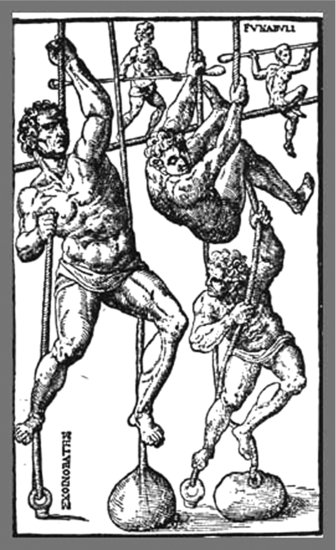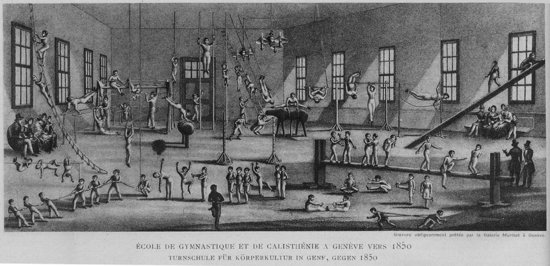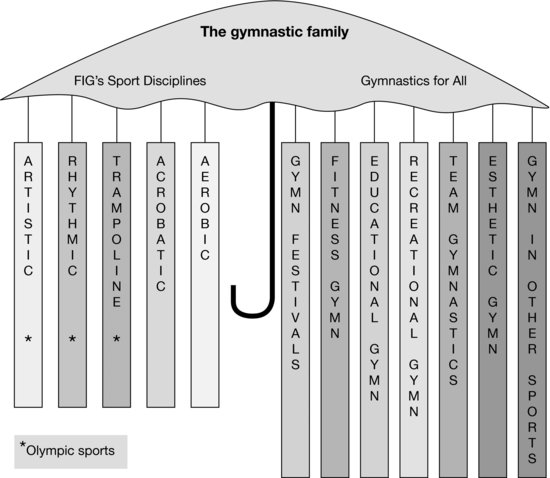s.” The aristocratic young men devoted considerable time to practicing various athletic endeavors to be contested at religious festivals. They also received education in music, letters, and philosophy.
The word “gymnastics” is today an umbrella term, much the same as “aquatics,” in that it encompasses not only a group of competitive sports but also many less formalized gymnastics activities in the fields of education, recreation, and fitness (Figure 1.1). These noncompetitive forms of gymnastics are showcased every year in gym festivals in many countries, some with over 100,000 participants. There is also the World Gymnaestrada held every fourth year with 20,000 participants. The Fédération Internationale de Gymnastique (FIG) is the world’s oldest international sport governing body (incorporated in 1881 as the Fédération Européenne de Gymnastique) and has a contemporary stable of sports that includes the four Olympic sports plus two non-Olympic multicategory sports of Acrobatic Gymnastics and Aerobic Gymnastics. In addition, there are three competitive subdisciplines of TG that are not contested in the Olympic Games but are included in all other TG competitions: Tumbling, Double Mini-Trampoline, and Synchronized Trampoline.
Gymnastics-type movement was performed in the ancient Chinese, Mesopotamian, Indian, and Mediterranean cultures, which all left ample records of the importance they placed on this type of physical exercise and body movement. It was the Greeks of the Homeric and Classical eras, however, who had the most lasting influence on subsequent educational and medical gymnastics practice. Their emphasis on mind/body integration in the education of their youth would greatly influence educators 18 centuries later. Plato, whose original name was believed to be Aristocles, was given the name Plato by his “gymnastai” Ariston of Argos because he had a broad (platon) and athletic chest (Yiannakis and Yiannakis, 1998).
The Romans followed the Greeks and continued many of their practices, but with more military emphasis. After the classical Greek era, the ensuing 10 centuries (the Middle Ages) had very little emphasis on sport, games, or the practice of integrating the mind and the body in education as extolled by the Greeks. It was not until the 1400s that we see a shift in thinking and a rebirth of the educational concepts introduced many centuries before by the Greeks. Let us trace how the contemporary sports and activities of gymnastics have coalesced via a fascinating and long journey through four primary ancestries: (1) the performing arts, (2) military training, (3) the medical professions, and (4) the education professions.
Gymnastics evolution from the performing arts
The earliest pictorial references to gymnastics activities come from paintings and engravings at several Egyptian sites. Most of them depict female performers tumbling and balancing and are dated from 2300 to 1000 BC (Touney, 1984). The tombs at Beni-Hassen show tumbling and ball passing and juggling skills that are surprisingly comparable to the contemporary sports of Tumbling and Rhythmic Gymnastics (Figure 1.2).
Figure 1.2 Ancient Egyptian gymnasts from tombs at Beni-Hassen (Source: Gardiner, E., Athletics in the Ancient World (1990) with permission from Oxford University Press.)

Around the same time, the Minoans, another great Mediterranean society centered on Crete, left many pictorial examples of performers vaulting and performing acrobatics on large adult bulls. Both male and female acrobats are illustrated and they appear to be paid professional performers (Gardiner, 1930). It would appear that subsequent societies on mainland Greece took much of their reverence of athleticism and physical fitness from the Minoans and it became an integral part of Greek education. The Homeric poems describe Corfu artists combining acrobatics and dance with ball and musical accompaniment (Frantzopoulou et al., 2011).
When we follow acrobatic performances through history, there is a clear thread of continuity running through them. The performances were often combined with dance and musical accompaniment, and are depicted in illustrations and text in both Western and Eastern civilizations. Chinese stone carvings from 1000 BC as well as 3rd century BC writing described acrobatic performances. By the 1st century BC, a combination of dance, acrobatics, and music called Juedixi was very popular in China. The circuses, traveling minstrel shows, and court performers throughout the world contained acrobatic performers and they often used a variety of devices to extend the acrobats’ time in the air. The ancient Minoans used the momentum from grasping a bull’s horns while being tossed in the air, while the Inuit of northern Canada used skins stretched between several throwers to toss one member high in the air to better see distant animals and also to entertain during celebratory events. The tossing of one acrobat by one or more others has a long tradition that continues in today’s Acrobatic Gymnastics. Many aerial enhancement devices like teeterboards, Russian swings, trapezes, and contemporary devices like Double Mini-Trampoline and Trampoline have a clear genesis in the performing arts, and circuses had such devices that allowed performers to be propelled into the air. American inventor and performer George Nissen used his springing invention in a three-person traveling “rebound tumbling” act called the Three Leonardos soon after designing and building it in 1934. It was while traveling in Mexico that he learned that the Spanish word for diving board was trampolin. It is obvious that the sports of Trampoline, Tumbling, Acrobatic Gymnastics, and Rhythmic Gymnastics can trace part of their lineage directly to the various performing arts that have evolved over the millennia.
Gymnastics evolution from military training
There was an obvious appreciation for physical prowess in most ancient societies as a requisite for survival. The ancient Greek city-states developed a strong competition ethos that resulted in intercity competitions in many endeavors including physical activities like running, throwing, wrestling, and calisthenics. Many of these activities were associated with military prowess and are wonderfully described in Homer’s epic poems the Iliad and the Odyssey. The Greek city-state competitions and regional athletic competitions evolved into large gatherings that culminated in four major games, one of which was the games at Olympia first documented in 776 BC. There was great debate in Greek literature about the value of so much time being devoted to training for these festivals, especially when the athletes became increasingly more professional and the rewards for winning multiplied (Manning, 1917).
The subsequent Roman Empire took these fitness arts to even greater sophistication but directed the training to military applications instead of purely athletic contests at religious festivals. One of the most influential medical writers in history was Claudius Galenus (Galen of Pergamon, 129–200 AD) who studied in the best medical schools in the Mediterranean region. He began his medical career treating the gladiators in his home city and was responsible for greatly reducing fatalities. Through this military medical exposure he learned much about training, rehabilitation, and the knowledge that physical fitness (gymnastics) was a natural and necessary part of life. Through his large body of publications he educated the entire world thereafter on Hippocratic theory and the practice of medicine (Machline, 2004).
It was not long after, that we see the first documentation on the use of wooden horses for military training. The first written description was a 375 AD description by Vegetius of a Roman legion training on them (Kaimakamis et al., 2007). In the 6th and 7th century Europe, military skills on the wooden horse were considered one of the seven knightly virtues, and there are many references to such military training. Soldiers practiced mounting, dismounting, vaulting over, and weapon use while mounted on wooden practice horses. The practice moved from military venues to fencing academies to universities, and we see it today in the sport of Equestrian Vaulting as well as pommel horse, and vaulting in both Men’s and Women’s Artistic Gymnastics.
A similar military influence is apparent with “Indian” clubs. There are ancient Persian and Indian depictions of stone and wooden clubs being swung as part of physical training. The British soldiers in colonial India were very impressed with the physical robustness of practitioners of “Indian” club (jori) swinging. The British army incorporated this exercise into their training, combining it with Swedish gymnastics. The first book to appear in Europe describing Indian club exercises was Donald Walker’s 1834 British Manly Exercises. This was followed a year later by another book Exercises for Ladies Calculated to Preserve and Improve Beauty in which Walker described the use of smaller, two pound Indian clubs he called “sceptres,” which are the precursors of contemporary clubs in Rhythmic Gymnastics (Todd, 2010). Indian club swinging subsequently became an important part of physical education training in many countries.
Other examples of military antecedents to contemporary gymnastics sports are the obstacle courses on which soldiers trained. The balancing and locomotory activities on horizontal logs and beams, the strength demands of rope climbing, the trapeze swinging, and the pole vaulting across ditches all led to future sport events. These types of activities, together with massed group calisthenics, were regular parts of military training, and they evolved, via inter-academy competitions, into several of today’s gymnastics apparatuses and competitive disciplines.
The 10 centuries following the Roman era (5th to 15th centuries) saw a decrease in intellectual and athletic pursuits that had been so prevalent during the Greek and Roman eras. There was, however, continual development of the military arts in which physical fitness and prowess were highly valued. During this time, the training of soldiers continued to employ and develop gymnastics-type skills and many military physical training instructors subsequently became the physical education teachers and sport masters in the public and private schools of Europe, thus establishing a prominent place for gymnastics in school physical education.
Gymnastics evolution from the medical professions
It is from the medical professions that we see the earliest writings on gymnastics. The word “gymnastics” was synonymous with purposeful exercise and could refer to running, physical preparation in general, or for wrestling and boxing. There were increasing references to “medical gymnastics” such as by Herodikos of Selymbria in the 5th century BC, and Galen’s De Sanitate Tuenda in 1st century AD. Galen advocated the importance of exercise in the cultivation of both the mind and the body (Bakewell, 1997). As previously mentioned, Galen’s writing on the virtues of exercise were little known during the Middle Ages in Europe, but were widely translated in Arabic and they strongly influenced Islamic medicine. It was physician Girolamo Mercuriale (or Hieronymus Mercurialis in Latin), who reintroduced Europeans to the teachings of the ancient Greeks. His book De Arte Gymnastica was the most influential book regarding this shift in medical thinking. Written in 1569 and reissued with elaborate illustrations of heavily muscled boxers, wrestlers, and gladiators in 1573, this book educated and influenced physicians and educators about the value of exercise, as taught by the Greeks (Figure 1.3). An earlier book, Libro del Exercicio by Spanish author Cristobal Méndez, was published in 1553 and advocated exercise for health, but it was mainly for Spanish speaking general readers and was not widely known to the Latin reading intellectual classes of Europe (Machline, 2004).
Figure 1.3 Gymnasts from Mercurialis’s 1573 book. (Source: De Arte Gymnastica, Girolamo Mercuriale (1573).)

About 100 years after Mercurialis, the Italian physiologist Giovanni Borelli (1608–1679) disputed Galen’s principles of movement and linked movement to mechanical laws and to contracting muscles and, as such, is regarded as the father of biomechanics. His two books De Motu Animalium I (1680) and II (1685) changed forever the way physicians and educators viewed movement and exercise. The human body was now considered a series of mechanical levers moved by muscles, which were elastic, dynamic, and needed to be maintained to function effectively. Gymnastics practice was about to change.
These and similar publications fueled an intense interest in ancient Greek ideals and many publications appeared during the British Enlightenment period extolling the health benefits of regular exercise (medical gymnastics). The British medical writer Francis Fuller (the Younger) published Medicina Gymnastica: A Treatise Concerning the Power of Exercise in 1705 and the essayist and magazine founder Joseph Addison wrote in the magazine Spectator in 1711 that he exercised 1 hour every day with a dumbbell (cast iron bell silenced by removing the clapper). Fellow countryman and physician George Cheyne published the very popular book Essay on Health and Long Life (1724) in which he advocated a wide array of daily exercises (Batchelor, 2012). Medical gymnastics now had a more scientific footing and was gaining acceptance in the medical professions. This was bolstered by the 1741 Paris publication of L’Orthopédia by Nicolas Andry in which he highlights bone plasticity and rehabilitative properties in children. Thus, we see the births of biomechanics, physical therapy, physical education, and orthopedics all occurring at the same time, and central to all was “gymnastics.” It is also a time of renewed emphasis on exercise and sport in public education. This was in part due to the revival of Greek educational philosophy, and in part to the medical professions’ imprimatur. There was also the role public education was playing in bolstering a population of healthy military-ready youth in the climate of growing nationalism.
Gymnastics evolution from the education professions
The Renaissance period (1400–1600) also saw many educators such as the Italian Vitorrino da Feltre and the Swiss Johann Pestalozzi reintroducing the Greek model of education. These educators and philosophers, who are often grouped under the banner of “humanists,” in turn influenced the Swiss Jean-Jacques Rousseau (1712–1778), and the German Johann Basdow (1724–1790) who both wrote extensively about “natural” education and strongly influenced our next group of four educators: GutsMuths, Vieth, Jahn, and Ling. It was this latter group who combined the scientific, medical, and educational changes into teaching systems, taxonomies of movement, and inventions of fitness apparatus that evolved into comprehensive systems of physical education (Figure 1.4). Now we can fill in the remaining parts of the history of present day gymnastics.
Figure 1.4 Swiss turnschule 1850. (Source: Huguenin A., 100 Years of the International Gymnastics Federation 1881–1981, FIG, Moutier, Switzerland 1981 with permission from Fédération Internationale de Gymnastique.)











